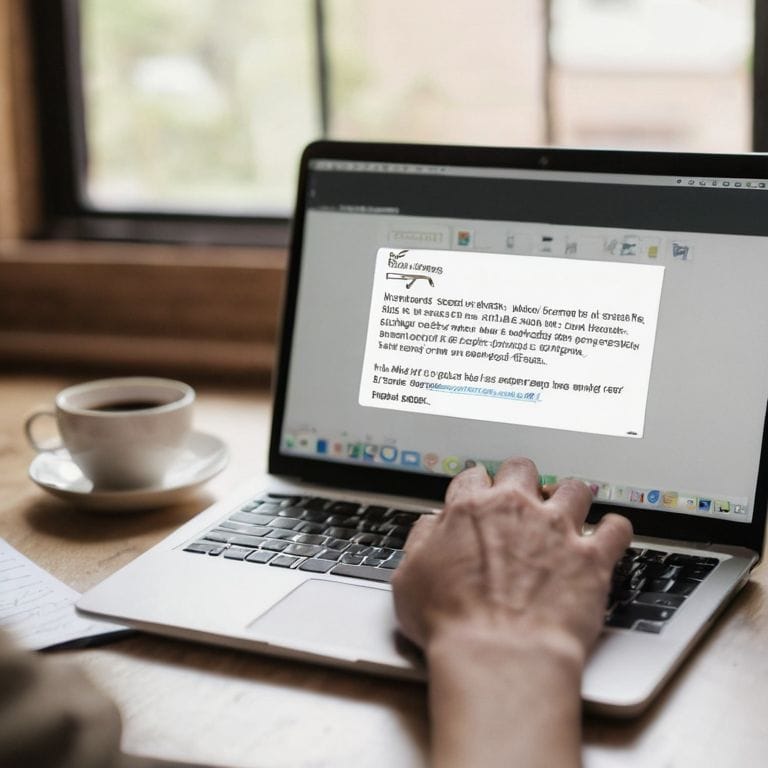Don’t Panic! Let’s get one thing straight: having a guide to online security doesn’t have to be overwhelming. I’ve seen many people believe that securing their online presence requires being a tech genius, but the truth is, it’s more like changing the oil in your car – a simple, routine task that keeps everything running smoothly. I remember when my grandma’s Facebook account was hacked, and she lost all her photos; it was a nightmare. But with the right steps, you can avoid such hassles and feel safe browsing the web.
In this article, I promise to walk you through a step-by-step process to lock down your online life. You’ll learn how to create strong passwords, recognize phishing scams, and use two-factor authentication to safeguard your accounts. My goal is to empower you with practical advice that’s easy to understand and implement, so you can enjoy the benefits of the internet without worrying about hackers. By the end of this guide, you’ll have a solid foundation in online security, and you’ll be able to protect your personal data with confidence.
Table of Contents
Guide Overview: What You'll Need

Total Time: 1 hour 30 minutes
Estimated Cost: $0 – $20
Difficulty Level: Easy
Tools Required
- Computer (with internet connection)
- Password Manager (optional)
Supplies & Materials
- Antivirus Software (free or paid)
- Firewall (built-in or third-party)
- VPN Subscription (optional)
Step-by-Step Instructions
- 1. First, don’t panic when it comes to online security – it’s easier than you think to get started. Begin by making a list of all your online accounts, including social media, email, and any shopping or banking websites you use. This will help you keep track of where you need to focus your security efforts. Think of it like taking stock of your car’s maintenance needs – you need to know what needs fixing before you can start tuning it up.
- 2. Next, update your passwords to something strong and unique for each account. A good rule of thumb is to use a combination of uppercase and lowercase letters, numbers, and special characters. Avoid using easily guessable information like your name or birthdate. You can also consider using a password manager to help keep all your passwords organized and secure. It’s like changing the oil in your car – it’s a simple step that can help prevent bigger problems down the road.
- 3. Now, enable two-factor authentication (2FA) wherever possible. This adds an extra layer of security to your accounts by requiring a second form of verification, such as a code sent to your phone or a biometric scan. It’s like adding a car alarm to your vehicle – it makes it much harder for someone to break in. Don’t worry if it seems complicated at first; most websites and apps will walk you through the process step by step.
- 4. Then, review your account settings to make sure you’re not sharing more information than you need to. Check your social media profiles to see what information is public, and consider adjusting your privacy settings to limit who can see your posts and personal details. It’s like adjusting your car’s mirrors – you want to have a clear view of what’s around you without giving away too much to others.
- 5. After that, install antivirus software on your computer and mobile devices. This will help protect you from malware and other online threats. Look for software that includes real-time protection and scheduled scans, and make sure to keep it updated regularly. It’s like getting a tune-up for your car – it helps keep everything running smoothly and prevents problems from building up.
- 6. Next, be cautious with links and attachments from unknown sources. If you receive an email or message with a link or attachment you weren’t expecting, don’t click on it or open it. Instead, contact the sender directly to verify that it’s legitimate. It’s like being careful when picking up hitchhikers – you don’t know what you might be getting into, so it’s best to err on the side of caution.
- 7. Finally, back up your data regularly to prevent losses in case something goes wrong. Consider using a cloud storage service or an external hard drive to keep your important files safe. It’s like keeping a spare tire in your car – you hope you never need it, but it’s a lifesaver if you do. Set a reminder to back up your data at least once a week, and make sure to test your backups periodically to ensure they’re working correctly.
A Guide to Online Security

As you continue to enhance your online security, it’s essential to understand the importance of cybersecurity best practices in protecting your personal data. One crucial step is to ensure that all your devices and software are up-to-date, as updates often include patches for security vulnerabilities. This is similar to changing the oil in your car – it helps keep the engine running smoothly and prevents potential problems down the road.
When making secure online transactions, it’s vital to verify the website’s authenticity. Look for “https” in the URL and a lock icon in the address bar, indicating that the site is encrypted and secure. This is like checking that your car’s doors are locked before leaving it unattended – it gives you peace of mind and helps prevent potential threats.
To further safeguard your online life, consider utilizing online security tools such as password managers and antivirus software. These tools can help detect and prevent common online threats, giving you an added layer of protection as you navigate the internet. By taking these extra steps, you can enjoy a safer and more secure online experience, free from the worries of hackers and cyber threats.
Cybersecurity Best Practices for Beginners
Don’t Panic! Let’s break down cybersecurity into simple, manageable chunks. As a beginner, it’s essential to start with the basics. Think of online security like maintaining your car – you need to keep it updated, clean, and protected from potential threats. Begin by ensuring your devices and software are up-to-date, as newer versions often include security patches.
By following a few straightforward best practices, you can significantly reduce the risk of cyber threats. Use strong, unique passwords for each account, and consider investing in a password manager to keep them organized. Be cautious when clicking on links or downloading attachments from unknown sources, and avoid using public Wi-Fi for sensitive activities. These simple habits will help you build a solid foundation for online security and give you peace of mind while browsing the web.
Protecting Personal Data From Common Threats
To protect your personal data from common threats, think of your online life like a car. You lock your car doors to prevent theft, right? Similarly, use strong, unique passwords for each account, and consider a password manager to keep them organized. Enable two-factor authentication (2FA) whenever possible – it’s like having a second lock on your car door.
By taking these simple steps, you’ll significantly reduce the risk of your personal data being compromised. Remember, online security is all about layering your defenses, just like how you might add a car alarm to deter thieves. Stay safe online, and don’t hesitate to reach out if you have any questions or need further guidance!
Don't Panic! 5 Essential Online Security Tips
- Use Strong, Unique Passwords for Each Account: Think of passwords like keys to your house – you wouldn’t use the same key for every door, so don’t use the same password for every account
- Keep Your Software Up to Date: Updates are like oil changes for your car – they keep everything running smoothly and fix problems before they become major issues
- Be Cautious with Email Attachments and Links: If an email looks suspicious, even if it’s from someone you know, don’t open attachments or click on links – it’s like being careful not to pick up hitchhikers on a road trip
- Use Two-Factor Authentication (2FA) Whenever Possible: 2FA is like having a deadbolt on your door – it adds an extra layer of security to keep the bad guys out
- Back Up Your Important Data Regularly: Backing up your data is like making a copy of your house keys – if something goes wrong, you can always get back in and recover what’s important
Key Takeaways for a Safer Online You
Don’t Panic! By following simple cybersecurity best practices like using strong, unique passwords and keeping your software up to date, you can significantly reduce the risk of online threats
Regularly back up your important data and consider using two-factor authentication to add an extra layer of security to your online accounts, making it much harder for hackers to gain access
Stay informed about common online threats and how to protect yourself from them – think of online security like car maintenance, where regular checks and simple precautions can prevent major issues down the road
Staying Safe Online
Online security isn’t about being a tech expert, it’s about being mindful of your digital footprint and taking simple steps to protect yourself – think of it as locking your car doors, but for your online life.
David Fletcher
Staying Safe Online: A Lasting Impact

As we conclude this guide to online security, let’s recap the essentials: we’ve covered the importance of using strong, unique passwords, enabling two-factor authentication, and being cautious with emails and links from unknown sources. We’ve also discussed how to protect personal data from common threats and the best practices for cybersecurity beginners. Remember, online security is an ongoing process, and it’s crucial to stay informed and adapt to new threats as they emerge. By following these steps and making them a part of your daily online routine, you’ll significantly reduce the risk of falling victim to cyber threats.
In the end, it’s all about taking control of your online life and being proactive about your security. Empowering yourself with the right knowledge and tools is the first step towards a safer, more secure online experience. As you continue on this journey, keep in mind that staying safe online is a marathon, not a sprint. With patience, persistence, and the right mindset, you can navigate the digital world with confidence and peace of mind, always ready to face whatever challenges come your way.
Frequently Asked Questions
What are the most common types of online threats that I should be aware of?
Don’t Panic! Common online threats include phishing scams, malware, and ransomware. Think of them like car hazards: phishing is like a detour sign trying to lead you astray, malware is like a flat tire slowing you down, and ransomware is like a roadblock demanding a toll. I’ll guide you through how to spot and avoid them.
How can I create strong and unique passwords for all my online accounts?
Don’t Panic! Creating strong, unique passwords is easier than you think. I recommend using a password manager to generate and store complex passwords for each account. Think of it like having a separate key for each car – it keeps everything secure and easy to manage. I’ll walk you through setting one up in the next step.
Are there any additional security measures I can take to protect my personal data when using public Wi-Fi networks?
When using public Wi-Fi, consider using a VPN to encrypt your data – think of it like putting your internet connection in a secure, private tunnel. This will help protect your personal info from prying eyes. I’ll show you how to set one up in my next guide, don’t worry, it’s easier than changing your car’s oil!









